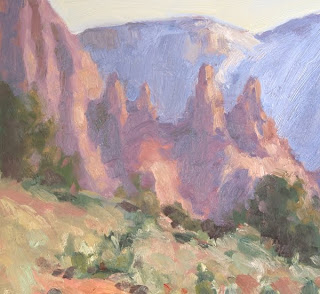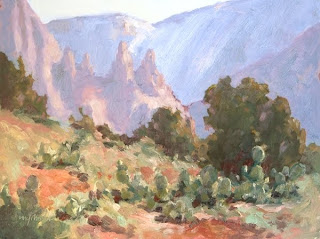
"Overlooking Crescent Moon Ranch" 9x12, oil
27 January 2010
Sedona, Arizona
It's hard to believe that it's already February and that our stay in Sedona is more than a third over. We've had some truly beautiful weather this time around. Most days have been sunny and warm, but even the rainy or snowy days gave me some great material to work with. If you've been following my blog (http://mchesleyjohnson.blogspot.com) you'll have seen many of these paintings. The blog, by the way, archives all of these images for you, so if you haven't seen them, you can easily find them. I've been painting a great deal this winter, so perhaps you'll find something you'll enjoy. I've also posted some recent photos of the area here: http://picasaweb.google.com/mcj.painter/SedonaWinter2010.
I recently delivered some new paintings to Windrush Gallery here in Sedona. These include a 36x48 piece featuring the Cockscomb and Doe Mesa as well as a number of nicely-framed 5x7s. These sizes should accommodate collectors at both ends of the spectrum - those looking for something big to go over the couch and also those looking to fill nooks and crannies in the hallway. (The little ones would make a nice grouping over the couch, too!) Windrush represents me exclusively in northern Arizona at 411 Highway 179 in the Garland Building, which is at the foot of Schnebly Hill Road. You can visit them online at www.windrushgallery.net or call them at 1-800-323-0115.
I'm proud to announce that I've been invited back to the Sedona Plein Air Festival this fall. This makes my fifth year participating. I'm looking forward to it, as always. This year, the festival runs October 23-20. For more, visit www.sedonapleinairfestival.com.
For those of you looking for a late-winter or early-spring workshop, I still have spaces in the Paint Sedona mentoring workshops. These are for the intermediate or advanced outdoor painter. If you want to bring your painting skills to the next level and to do it in a beautiful place, give me a call. Don't forget that the price includes six nights lodging and two meals a day. And as I mentioned in my last newsletter, we have a deal. If you bring a friend and stay in separate rooms, you each can take $100 off the fee. Normally, it's $1000 each, but with this "two-fer" deal, it'll only cost you $900! Some of you have asked about attending as day students, and yes, you can attend the week for $300. For more, visit www.paintsedona.com or contact me directly.
If you're new to pastels or would like to try them for the first time, I'm teaching a 6-session Introduction to Pastel class for the Sedona Arts Center. This is a studio class, so if you don't like the thought of painting outside, this is the one for you! From February 20 to March 27, we'll meet Saturday afternoons from 2 to 5. Cost of the workshop is $162 for SAC members, $180 for non-members. For details and to register online, visit http://activenet13.active.com/sedonaartscenter/servlet/adet.sdi?activity_id=133&show_all=&pagenum=1&paid=.
A second workshop I'm teaching through the Sedona Arts Center is a field expedition to Marble Canyon, on the Upper Colorado River. This exciting adventure includes four days painting on the rim plus a one-day boat trip (no white water, promise!). Lodging, breakfast and dinner are included in the $1400 fee. This will be a workshop taught jointly with painter David Haskell. I'll be teaching pastel and David will be teaching oil. For details and to register online, visit http://activenet13.active.com/sedonaartscenter/servlet/adet.sdi?activity_id=24&show_all=&pagenum=2&paid=
After Sedona, I have many workshops coming up for painters of every level. Locations include: Utah, Illinois, Indiana, Vermont, New Hampshire, Texas, Maine and, of course, Campobello Island. Following this letter is a complete list of my 2010 workshops.
Finally, don't forget that I have several publications out now. Two books, two DVDS, a portfolio and a calendar. You can find out more about these at my website at http://www.michaelchesleyjohnson.com/html/book.htm.
Have a great winter, and I hope to see you soon!
Michael
Prepare for Plein Air: Not sure how to go about painting outside? Check out my online course! Great for beginners. Visit www.PrepareForPleinAir.com
2010 Workshops
- January, February, March: ARIZONA, Sedona - All media. Weeklong, half-day mentoring workshops following the Campobello Island model - Price $1000. Intermediate/Advanced students only with plein air experience. See www.PaintSedona.com for details. (And don't forget our "two-fer" deal as noted above!)
- February 20-March 27: ARIZONA, Sedona. Weekly studio pastel class through the Sedona Arts Center. Meets 6 Saturdays. Price: $162 SAC members, $180 non-members. Contact: Sedona Art Center, 1-888-954-4442, www.sedonaartscenter.org.
- April 12-16: UTAH, Ivins - Oil or pastel. Join Michael in the art colony of Coyote Gulch at Blue Raven Studio (www.blueravenartstudio.com) for a week of plein air painting. Beautiful Utah scenery including Snow Canyon and Zion National Park. Price: $350. Contact: Kathy Heiner, 435-674-7425, glasslady53@msn.com
- April 19-23: ARIZONA, Upper Colorado River (Marble Canyon) - Oil or pastel, Joint workshop with oil painter David Haskell, painting from the rim of the Canyon plus a boat trip! Michael will do pastel; David will do oil. Price: $1400. Contact: Sedona Art Center, 1-888-954-4442, www.sedonaartscenter.org.
- April 29-May 1: ILLINOIS, Springfield - Pastel only. Join Michael for a three-day outdoor painting workshop in Abe Lincoln's hometown with the Illinois Prairie Pastel Society. Scenery includes the Lincoln Home National Historic Site. Price: $250 IPPS members, $300 non-members. Contact: George King, 217-483-9030, geezer222@comcast.net FULL- Waiting List
- May 3-5: INDIANA, Valparaiso - Oil & Pastel. Join Michael for a three-day workshop at The Art Barn School of Art. Price: TBA includes lunch. Contact: ArtBarnIN@AOL.com, 219-462-9009, www.artbarnin.com
- May 8-9: VERMONT, Montpelier - Pastel only. Sponsored by the Vermont Pastel Society. Price: $170. Contact: Michael Chesley Johnson, 575-267-2450, mcj@sff.net
- June 23-25: NEW BRUNSWICK, Saint John - Oil & Pastel. Sponsored by the Saint John Arts Centre. Price: CA$180. Contact: Saint John Arts Centre, 506- 633-4870, www.saintjohnartscentre.com, info@saintjohnartscentre.com
- June-mid-September: CAMPOBELLO ISLAND, New Brunswick, Canada - All media. Weeklong, half-day plein air workshops for all levels (students need some prior painting experience.) Paint half the day, explore the island the rest! $300/week. (Deal! Bring a friend, and get $50 off your tuition.) Contact: Michael Chesley Johnson, 575-267-2450, mcj@sff.net. See website for full list of weeks available - www.MichaelChesleyJohnson.com.
- August 9-13: NEW BRUNSWICK, St Andrews - Oil & Pastel. Sponsored by Sunbury Shores Arts & Nature Centre. Price: TBA. Contact: Sunbury Shores Art & Nature Centre, www.sunburyshores.org, 506-529-3386, info@sunburyshores.org
- September 22-25: NEW HAMPSHIRE, Goffstown - Oil or pastel. NOTE: This is a Wednesday-Saturday, 4-day workshop. Price: $290 members. Contact: New Hampshire Plein Air, Sharon Allen at msjallen@comcast.net.
- September 27-October 1: MAINE, Acadia National Park. Oil or pastel. Michael's sixth year teaching in Acadia for the Acadia Workshop Center! Price: $550. Contact: Gail Ribas, 207-460-4119, info@acadiaworkshopcenter.com.
- October 18--20: TEXAS, Waxahachie. Oil only. Join Michael for three days of autumn in northern Texas. Price: TBA. Contact: TBA
- November 29-December 3: TEXAS, New Braunfels. Oil or pastel. Join Michael for a week of painting in beautiful Texas "Hill Country." Price: $345. Contact: Mary McIntosh, 1863farmroad@sbcglobal.net, 830-625-0132

 Maybe you've already guessed from the color harmonies and other clues that they are from the same painting. When I painted the original, a 9x12, I was over-ambitious. Here it is:
Maybe you've already guessed from the color harmonies and other clues that they are from the same painting. When I painted the original, a 9x12, I was over-ambitious. Here it is: I really loved that clump of prickly pears, and I really loved those rocks in the distance. The result of loving all parts of the scene a little too much can be the classic "Two Paintings In One" mistake. When my students do this and we get to the critique session, I don't say a word but pull out a couple of pieces of mat board and do some impromptu cropping. Their faces light up at once. Even I'm amazed at the great compositions the students made - once I put the cropping tools to their work.
I really loved that clump of prickly pears, and I really loved those rocks in the distance. The result of loving all parts of the scene a little too much can be the classic "Two Paintings In One" mistake. When my students do this and we get to the critique session, I don't say a word but pull out a couple of pieces of mat board and do some impromptu cropping. Their faces light up at once. Even I'm amazed at the great compositions the students made - once I put the cropping tools to their work.

































